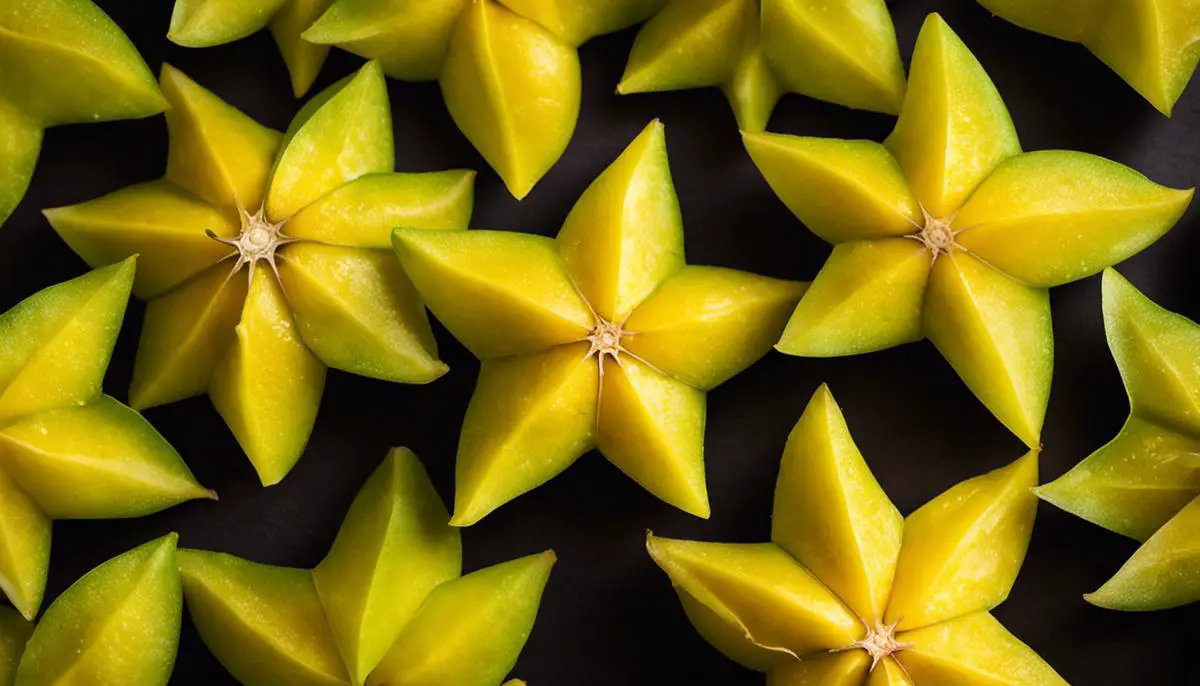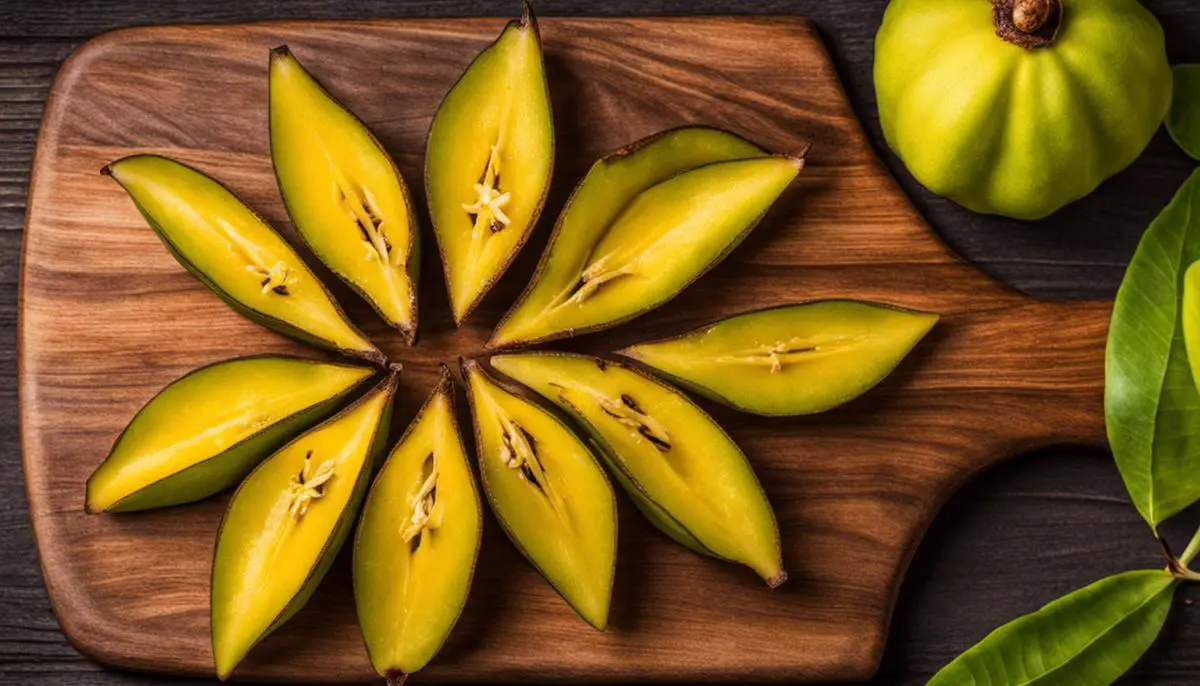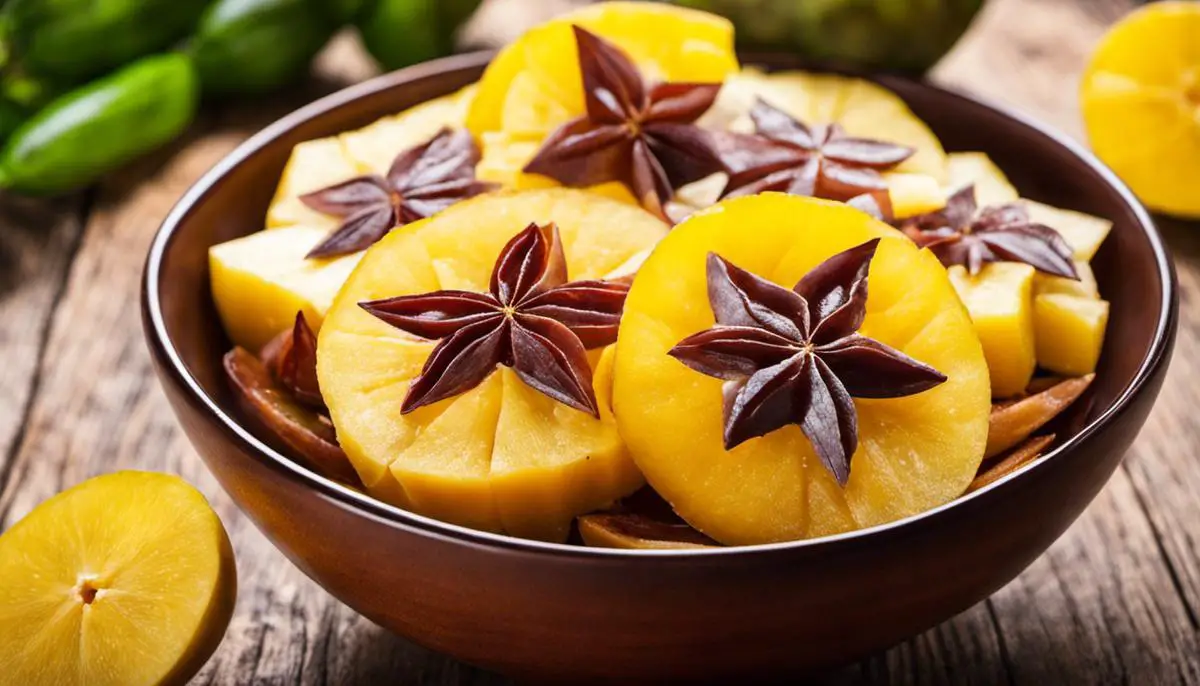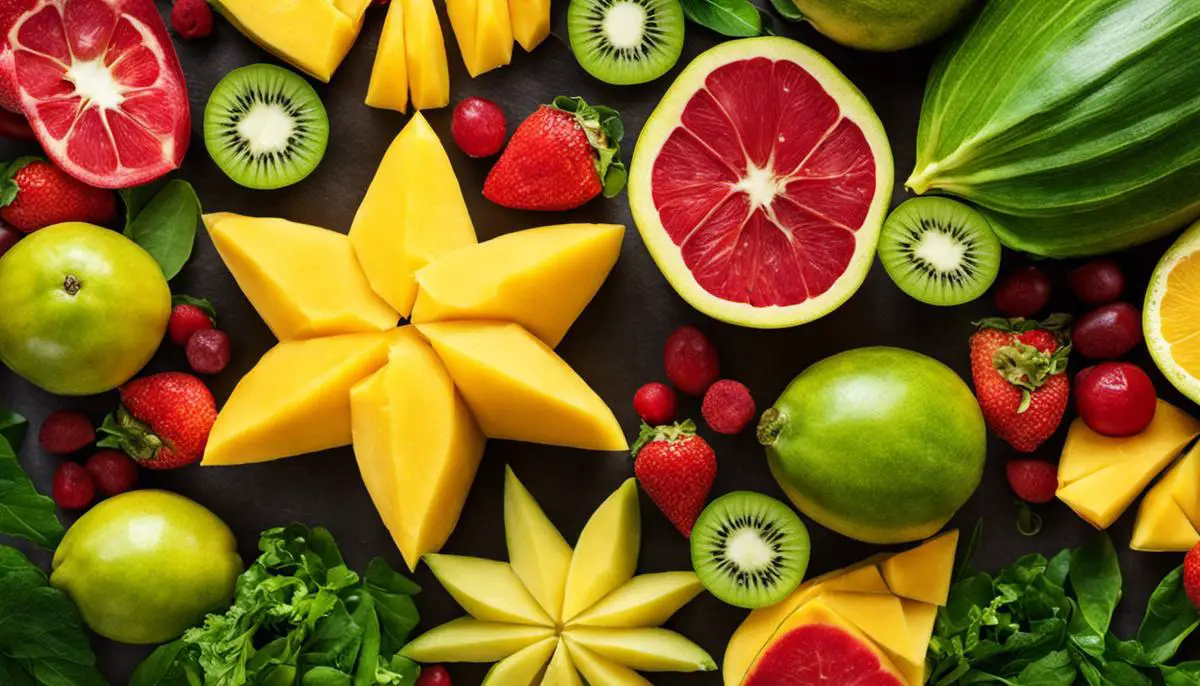In a world where invasive diseases loom and health is wealth, understanding the rich constituents of our diet can be a game-changer. Among these constituents, the humble carambola or star fruit offers a bounty of nutrients that promise numerous health benefits. Resembling a star when sliced, these tropical delights originate from Southeast Asia, and are not only a treat for the palate but also packed with remarkable anti-inflammatory properties. This enlightening piece will take you on a journey of the carambola, from its physical attributes to its impressive nutritional profile, its scientific backing as a natural anti-inflammatory agent, and finally, how to incorporate this star player in your diet.
Understanding Carambola
Understanding the Carambola (Star Fruit)
Carambola, also known as star fruit due to its distinctive star-like shape, is a tropical fruit that is native to Southeast Asia. The fruit’s tree, Averrhoa carambola, is found widely cultivated in tropical regions such as Malaysia, Sri Lanka, and Indonesia, but also extends to temperate areas, becoming popular in the western world in recent years. The carambola tree can mature to a height between 5 to 10 meters with rose-pink flowers that bud annually, yielding the uniquely shaped fruit.
Carambola presents itself in an oblong shape, growing four to six inches in length. When cut cross-wise, it displays the characteristic star, contributing to its alias “star fruit.” The skin is a glossy, bright yellow when ripe, encasing crisp, juicy, translucent flesh that dishes out a blend of sweet and sour flavors.
Nutritional Value and Constituents of Carambola
Packed with a host of essential vitamins and minerals, carambola stands as an impressive nutritional powerhouse. A single, medium-sized star fruit (~91 grams) contains around 28 calories only, making it an ideal option for those monitoring calorie intake. Low in fat and high in dietary fiber, this tropical fruit proves to be beneficial in supporting a healthy digestive system.
It is rich in vitamin C, providing almost 57% of the daily value per serving, thereby aiding in boosting immunity levels. The fruit also contains significant amounts of vitamin A, B-complex vitamins, and trace amounts of vitamin E.
Minerals in carambola include potassium, zinc, phosphorus, and iron, but perhaps its most salient mineral constituent is its high magnesium content. It carries anti-inflammatory properties which can aid in managing conditions like arthritis and asthma.
Unveiling the Anti-Inflammatory Potentials of Carambola
Carambola, commonly known as star fruit, is believed to be a potent natural anti-inflammatory due to its rich content of antioxidants and phytochemicals, notably, flavonoids such as quercetin, epicatechin, and gallic acid. These unique compounds have been observed to relieve inflammation, potentially reducing swelling, redness, and pain throughout the body.
Quercetin, a type of flavonoid, can suppress the production and release of cytokines and histamines, the agents that trigger inflammation. Similarly, other ingredients such as epicatechin and gallic acid seemingly deter inflammatory responses at the cellular level, making carambola a possible useful dietary addition for individuals dealing with inflammatory conditions.
Moreover, the abundance of polyphenol antioxidants in carambola can defend the body against harmful free radicals, minimizing oxidative stress, a contributor to chronic diseases such as cancer and heart disease. While there is still a wealth of research to be done to validate these benefits fully, the nutritional virtues of carambola, especially its potential as an anti-inflammatory, makes it a worthy contender for inclusion in your meals.

Carambola and Inflammation
Exploring the Bioactive Compounds Contributing to Carambola’s Anti-Inflammatory Properties
Carambola contains various beneficial bioactive compounds that play a crucial role in its anti-inflammatory properties. The flavonoid epicatechin is one such compound; several scientific studies have established it as a powerful anti-inflammatory and antioxidant agent. It operates by intercepting the production of molecules that instigate inflammation.
On the other hand, quercetin, a polyphenolic compound, is celebrated for its anti-inflammatory, antioxidant, and antihistamine qualities. This versatile compound works as an anti-inflammatory agent by restraining inflammatory signals within cells, hence curbing the body’s tendency to respond with inflammation.
In addition to these, carambola is also rich in vitamin C, a recognized antioxidant. While its role in enhancing the immune system is widely known, it also combats inflammation by neutralizing the harmful free radicals that can incite oxidative stress and inflammation.
Scientific Research Supporting Carambola’s Anti-Inflammatory Property
Several scientific studies have supported the claim that carambola can act as a natural anti-inflammatory. A study published in the Journal of Agricultural and Food Chemistry found that extracts from the fruit demonstrated potent anti-inflammatory properties in a laboratory setting.
Another study in the Journal of Ethnopharmacology identified that carambola’s anti-inflammatory effects were due to its capable inhibition of nitric oxide production. Nitric oxide is a molecule that plays a key role in the inflammatory process. By inhibiting its production, carambola can potentially quell inflammation effectively.
Likewise, a study featured in the International Journal of Biological Macromolecules found that a specific polysaccharide derived from carambola had both antioxidant and anti-inflammatory effects.
However, more human clinical trials should be conducted to verify carambola’s direct anti-inflammatory effects and determine the appropriate quantities and forms for consumption to maximize these benefits.
Exploring Carambola: A Natural Anti-Inflammatory Addition to Your Diet
Integrating carambola, also known as star fruit, into your daily meal plan offers a natural avenue to help fight against inflammation. This versatile fruit can be consumed raw, turned into juice, or even used as an ingredient in various recipes. It’s important to remember, however, while carambola holds promise as a natural anti-inflammatory, it should not act as a replacement for professional medical advice or treatment for ongoing inflammation.
Due to its high concentration of oxalic acid, individuals with kidney-related health conditions should exercise caution consuming this fruit. Always seek guidance from a healthcare provider or a qualified nutritionist to determine the best approach to adding this fruit into your diet, especially if you have existing health concerns.

Health Benefits of Carambola
Understanding Carambola’s Anti-Inflammatory Properties and Other Health Benefits
The starfruit, formally known as carambola, is a symbol of potent anti-inflammatory attributes. The fruit’s characteristic star-like shape when cut crosswise has made it a visually appealing healthy treat. Its anti-inflammatory impact is primarily attributed to the substantial presence of polyphenols, flavonoids, and antioxidants. Research has revealed these bioactive compounds work to adjust the body’s inflammatory reaction by inhibiting the secretion of inflammatory indicators and decreasing oxidative stress. They may support in reducing the symptoms related to chronic inflammation and various inflammatory conditions.
Beneficial for Cardiovascular Health
Besides its anti-inflammatory properties, carambola holds significant benefits for cardiovascular health. The fruit is high in fiber, which is known to help reduce levels of low-density lipoprotein (LDL), or “bad” cholesterol, reducing the risk of atherosclerosis and heart disease. Moreover, its antioxidants help prevent the oxidation of LDL cholesterol, thereby preventing plaque buildup in the arteries. Potassium, another component found in abundance in carambola, plays a role in maintaining heart function by regulating blood pressure levels.
Contributing to Digestive Health
The fiber content in carambola is not only good for heart health but also essential for maintaining a healthy digestive system. Dietary fiber aids to increase the bulk of the stool, preventing constipation and promoting a healthy bowel movement. Moreover, it’s believed that the fruit contains antimicrobial properties that are thought to prevent the growth of harmful bacteria in the gut.
Promoting Skin Health
Carambola is abundant in vitamin C, a powerful antioxidant that plays an integral role in maintaining skin health. Vitamin C helps to boost collagen production, a protein that provides structure and elasticity to the skin. Additionally, the fruit’s antioxidants fend off free radicals, which can cause skin damage and accelerate the aging process. Some studies also suggest that the fruit’s anti-inflammatory properties can soothe skin inflammation, making it potentially beneficial for skin conditions like eczema and psoriasis.
Limitations and Precautions
While carambola has many potential health benefits, certain groups should consume it with caution. The fruit contains a notable amount of oxalates and has been found to have potential toxic effects on individuals with kidney disorders. In such circumstances, it’s advisable to seek medical advice before including carambola in the diet.
Moreover, it’s crucial to note that while carambola may help alleviate symptoms or complications associated with various health conditions, it should not replace any medical treatments prescribed by a healthcare professional. Use it as a part of a balanced diet and not as a solitary solution for health issues. It’s also essential to maintain a diverse diet to meet your nutritional needs effectively.
Understanding Carambola’s Health Benefits
Carambola, frequently called starfruit, is abundant in vitamins, minerals, and bioactive compounds that collectively establish its remarkable anti-inflammatory properties. Regular but moderate consumption of this tropical fruit can potentially contribute to enhanced cardiovascular and digestive health, improved skin conditions, and other wellness benefits. Though beneficial, it’s vital to be aware of the potential risks it might pose to individuals with certain health conditions.

How to Include Carambola in Your Diet
Integrating Carambola into Your Diet
To take advantage of the starfruit’s natural anti-inflammatory and health-boosting characteristics, consider incorporating it into your daily nutritional plan. Numerous benefits stem from the starfruit’s rich array of vitamins, minerals, and antioxidants that all work together to counter inflammation and promote overall health.
Simple Recipes with Carambola
Preparing the carambola is straightforward. Rinse the fruit, cut off the ends, and slice it into star-shaped pieces. You can choose to remove the seeds, but it is not necessary as they are edible. The entire fruit – skin included – can be eaten and is packed with beneficial compounds.
One simple way to consume carambola is by incorporating it into a fresh, tropical salad. Mix slices with other tropical fruits such as mango, banana, and pineapple, then drizzle with lime juice for a refreshing dish.
For a savory twist, carambola pairs well with grilled fish or chicken. It can be added to a salsa with diced tomatoes, onions, cilantro, and lime juice. This salsa can top grilled meats for a nutrient-packed meal.
Carambola is also excellent for blending into a smoothie with some banana, spinach, and a splash of almond milk. The fruit adds a unique, tangy flavor and an abundance of nutrients to the smoothie.
Precautions for Certain Groups
While carambola can be a beneficial addition to most diets, certain individuals should be cautious. Primarily, those with kidney problems should limit or avoid the fruit. This is due to its high content of oxalates, which could contribute to kidney stone formation. Individuals with renal impairment or chronic kidney disease should especially avoid this fruit, as it can lead to overpowering neurotoxin buildup and potentially fatal outcomes.
Moreover, carambola is high in vitamin C and fiber, but also contains a considerable amount of sugar. Therefore, individuals with diabetes should avoid consuming carambola in large quantities. They can choose to incorporate it into their diet in moderate amounts, monitoring their blood sugar levels carefully.
Consuming carambola moderately, and paying attention to any adverse reactions, is essential when first incorporating this fruit into your diet. As with any food, discuss it with your healthcare provider, especially if you have known health conditions.
Carambola as a Natural Anti-Inflammatory
Carambola contains significant levels of antioxidants, including vitamin C, quercetin, and epicatechin, that contribute to its anti-inflammatory properties. These antioxidants combat oxidative stress in the body, which is a primary cause of inflammation. Regular consumption of foods rich in these nutrients could potentially lead to a reduction in inflammatory conditions.
Inflammation is a natural response of the body to defend against harmful invaders, but chronic inflammation can lead to health conditions such as heart disease or arthritis. Including anti-inflammatory foods like carambola in your diet can be a simple, natural way to help keep inflammation under control.

Indeed, the star fruit is a hidden gem in the world of natural remedies, particularly for inflammation. The health benefits it confers extend not only to combating inflammation but also to improving heart health, aiding digestion, and enhancing skin health. As we steer towards a more health-conscious society, being intentional about our food choices, like including carambola in our diet, becomes crucial. However, it’s important to bear in mind that while carambola can be a beneficial supplement to our diet, excessive consumption may not be advised for certain individuals. It’s always wise to understand these considerations and eat accordingly. Ensuring a balanced diet with a wise incorporation of nutrient-dense foods like carambola paves the way for a healthier life journey, one star slice at a time.
